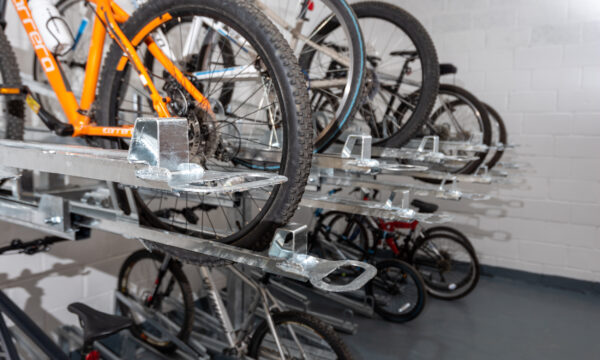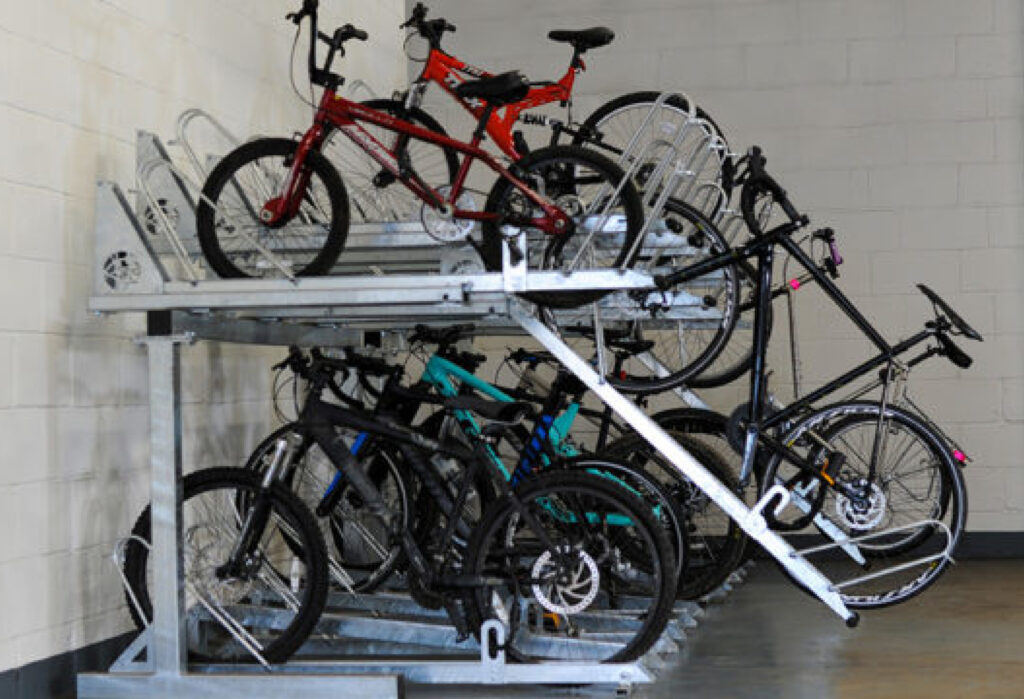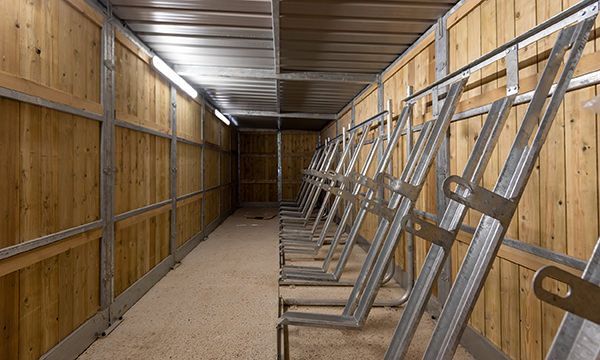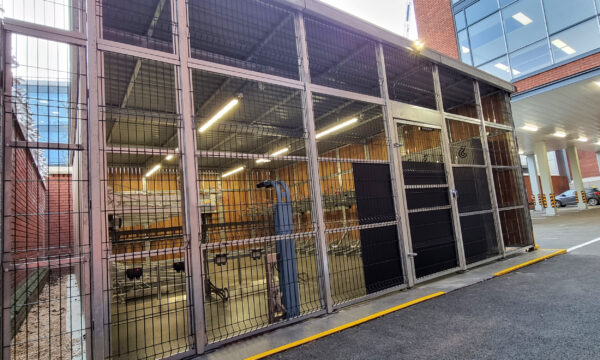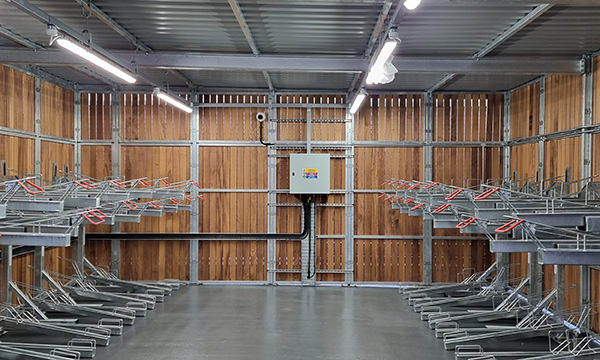Commonly specified for high-density developments where the available footprint represents a constraint, two-tier bike racks provide secure storage for the maximum number of bikes per square metre, utilising vertical height to reduce the use of horizontal space.
Available as 3 distinct model variants, including gas-assisted, manual, or fixed, the aim of two-tier bike racks remains consistent: to maximise bike storage capacity while prioritising user convenience.
The following article provides insight into the key considerations for two-tier bike racks, evaluating the key differences between variants for architects and specifiers to help ensure a positive user experience.
A Brief History of Bike Racks
Bike racks first came about in the 19th century when bikes were on the rise as a form of transportation in urban towns and cities. The earliest forms offered a simple means of bike parking that secured the front wheel only via grooved concrete or a forked metal, however, these were largely ineffective designs for ensuring security, while not offering much in the way of stability as only the front wheel was held in place, leading to the term “wheel benders” among cyclists. The Sheffield stand was first developed to provide a solution to this problem.
With a focus on increasing accessibility and security, the ‘Dutch Two-tier Rack’ was the first example of a bike racking system with two tiers and gas-assisted, moveable upper sections. Invented by Dutch company Jan Kuipers in 1929, it revolutionised the development of bike racking systems, setting a precedent that endures to this day, with the design form now well-established across Europe nearly a century later, particularly in the Netherlands.
Two-tier bike racks will often be utilised for communal bike storage projects and integrated within bike hubs, indoor bike parking facilities and bike shelters. In recent years, two-tier bike racks are also seeing increased utilisation in the UK, often in high-density settings such as public transport hubs, where optimum capacity is a key consideration. The city of Cambridge, one of the UK’s top cycling cities, recently developed a new bike park at the city’s railway station, constructed as part of their station redevelopment in 2016. Utilising a range of bike parking types, including two-tier racks, the bike park accommodates nearly 3,000 bikes to provide secure bike parking for commuters and city residents.
Two-tier Bike Racks – The Variants
Two-tier bike rack variants include:
- Gas-Assisted Lift Two-tier Bike Racks
- Manual Lift Two-tier Bike Racks
- Fixed Two-tier Bike Racks
The main difference between two-tier bike rack variants is how bikes are loaded and unloaded from ground level. The availability of gas-assisted lifting mechanisms assists users by supporting the weight of the bike, enabling easier raising of bikes to the upper tier of the rack and opening up access to those with mobility restrictions.
Operating the manual-lift counterpart largely follows the same process, with the exception that users are required to support the weight of the bike when loading and unloading. Fixed two-tier racks offer a straightforward approach, providing dual-level parking without lifting mechanisms.
How to Operate Two-tier Racks
urbanspec’s step-by-step guide provides directions on how to operate a gas-assisted lift two-tier bike rack. Manual lift systems can be operated by following these steps:
- Step 1 – Pull the upper-tier tray of the rack outwards using the handle and lower it towards the floor, locking at a 45° angle.
- Step 2 – Support the bike by holding the handlebar with one hand and the seat with the other, and carefully lift the bike onto the tray.
- Step 3 – Place the front wheel into the tray first, then secure the rear wheel. The chassis will hold the weight of the bike without risk of it falling off.
- Step 4 – Ensure the wheels are properly secured, and lift the upper-tier tray until it is horizontal.
- Step 5 – Push the upper-tier tray back, returning it to the original position with the bike held securely.
Fixed two-tier bike racks remove the cantilever action for raising and lowering bikes to the upper-tier tray. They utilise two fixed levels for bike parking, with users placing the bikes in the trays at ground level or lifting the bikes into the trays in the upper tier trays in order to store them.
Space Requirements and Dimensions
Preferential spacing between bikes and appropriate loading distance are key requirements for any two-tier bike rack installation, regardless of the variant selected. A well-designed layout is conducive to a positive user experience. Ensuring adequate horizontal spaces, and clearance height is a primary consideration to ensure appropriate space is available within the height of the enclosure, as well as the necessary depth to safely load and unload bikes from the racks. Space requirements include:
- Minimum ceiling height of 2700mm for the upper tier
- Preferential spacing of 400mm between each bike parking space within the rack to prevent handlebars or pedals of bikes from clashing.
- Minimum aisle width of 1800-2000mm to load and unload bikes.
- 2500mm of frontal space if racks are installed at 90 degrees to an aisle
- 2000mm of frontal space when racks are installed at 45 degrees
urbanspec T2
Designed and manufactured in the UK, urbanspec T2 Two-tier Bike Racks are constructed around a robust and highly durable fully-welded steel chassis, forming the support frame for the upper tiers. Galvanised steel wheel trays with end constraint bars ensure both wheel wells are securely held, with Integral locking frames allowing different bike types and sizes to be secured effectively.
Product design for urbanspec T2 Two-tier Bike Racks incorporates features to maximise usability, security, long service life and aesthetics, with extensive capacity configurations available to ensure effective storage for any number of bike spaces required. Brand products, including urbanspec Bike Hubs and Shelters are available and designed especially to accommodate two-tier bike racks.
The availability of CAD models provides key assistance during the design evaluation process to ensure space requirements and dimensions for height and depth are accommodated.
